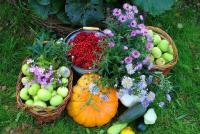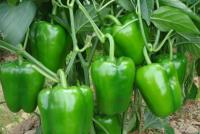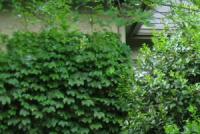Growing blue hydrangea in room conditions: the basic rules of care and reproduction. Blue hydrangea: care and cultivation at home.
Change the color of hydrangea
You may have heard that you can change the color of the hydrangea flowers by adjusting the pH of the soil.
But there are some nuances that do not depend on the acidity of the soil, let's see in more detail.
First, not all hydrangeas can be blue.
Hydrangeas with white or cream flowers such as Annabel can only be white or cream.
But sometimes they can become pink at the end of the season.
Hydrangeas, which range from pink to blue and purple, usually belong to certain varieties of hydrangea, known as mopheads and lacecaps.
These types of hydrangeas have an interesting opportunity to change color based on soil chemistry.
When grown in alkaline soil, the color is pink.
When grown in acidic soil, the color is blue.
The composition of the soil plays an important role on the color of hydrangeas, there are varieties such as Nikko Blue, Pretty in Pink, they all have almost equal chances to bloom in pink or blue depending on the soil they are planted on.
So remember that even if you buy hydrangea in bloom, you cannot be sure that it will be the same color to bloom in your garden.
In order to control the color of the hydrangea, you need to manipulate your soil, the pH level and the mineral content.
But remember a sharp change in the pH of the soil can bring to the death of your plant.
It is necessary to change the level of soil pH gradually so as not to harm the plant.
You can get blue hydrangea flowers if the soil is at a pH of 5.2-5.5.
If the soil is alkaline, you can lower the pH by applying acidic organic mulch, such as pine needles or pine bark.
If you prefer pink flowers, your hydrangeas should be deprived of aluminum, growing it in alkaline soil with a pH of 6.0-6.2.
You can apply phosphate fertilizer to further inhibit the absorption of aluminum.
Raise soil pH
Wood ash also increases soil pH.
It works much faster than lime and adds potassium to the soil.
But be careful when applying wood ash.
It is very focused, and applying too much can dramatically change the pH and cause imbalances in nutrients.
Lower soil pH
The soil can be more acidic by adding an acidulant to the soil, ammonium sulfate or aluminum sulfate.
You can lower the pH level by incorporating acidic organic materials such as pine needles, sawdust, peat, and oak leaves.
Coffee grounds also slightly acidify the soil.
A blooming hydrangea will decorate a small garden or front garden, even in partial shade this deciduous shrub with large inflorescences turns the garden into a beautiful fairy tale.
General information
By all accounts, hydrangea is considered one of the most beautiful flowering shrubs.
Planted hydrangea bushes can form hedgeIt looks great when framing garden paths.
Many varieties of hydrangea garden feel great in the sun and in partial shade.
Large-leaved hydrangea
The most popular among garden hydrangeas, deservedly enjoys large-leaved hydrangea. Lush spherical inflorescences behind which foliage is almost invisible will beautify even an unkempt garden.
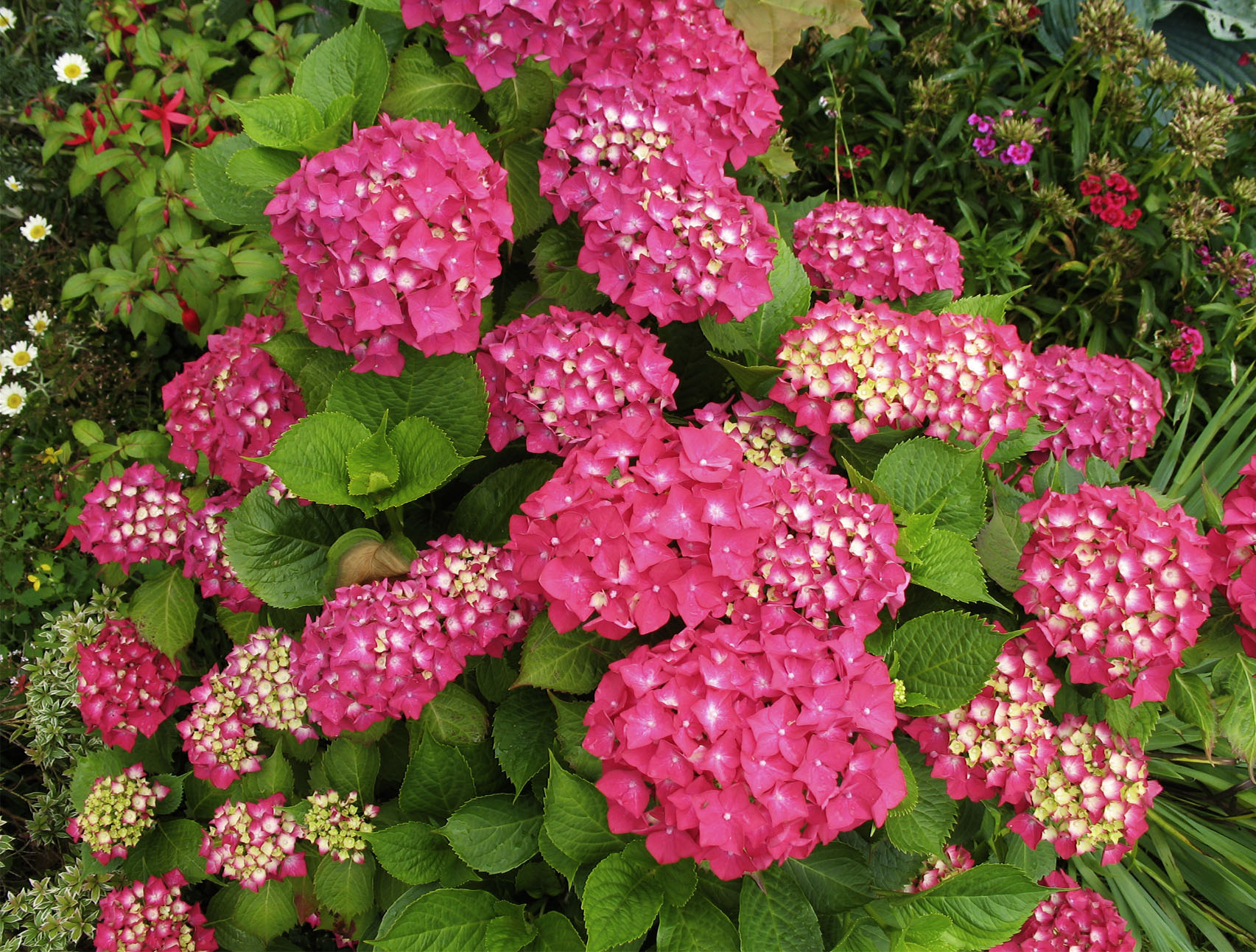
In many Western countries, large-leaved hydrangea is a favorite of the rural garden, its spectacular inflorescences adorn the bush until autumn.
This flowering shrub looks great in a group of flowering perennials, thereby emphasizing its color accents.
Many varieties of leafy hydrangea feel great in the sun and in partial shade. In the climatic conditions of Russia, many problems arise for the safety flowering shrubs in cold weather. After a stable negative temperature has been established, all the bushes cover (rhizomes are filled with compost, 15–20 cm high, all this is covered with lutrasil and covered with lapnik). Very good for the winter bushes fall asleep with snow, for this you need a shovel for snow removal. Modern shovels are lightweight and even a teenager will be able to shrub the snow up to the top of his head.
Potted Hydrangea
Potted hydrangea is a derivative of large leaf hydrangea, but it is an absolute sissy.
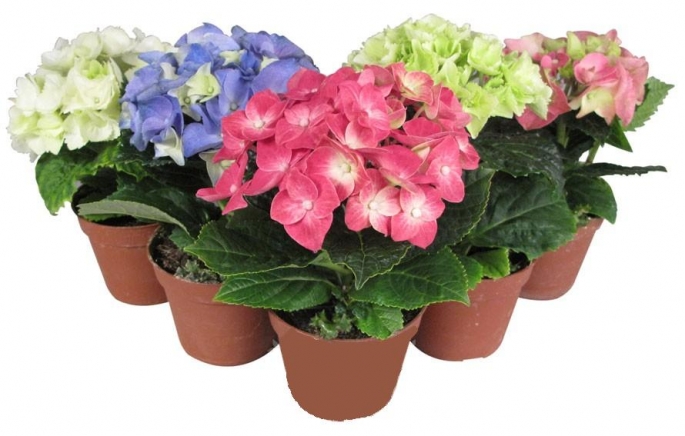
In the summer months, outdoors, pottery hydrangea can only live in the shade, it has a variety of varieties and colors.
At the first frosts, the pot hydrangea requires reliable shelter; it is necessary to move it to a winter garden or a cool room.
Hortense loves moisture
Hydrangea has the generic botanical name Hydrangea - which means "water lover" in Greek.
And indeed, by this beautiful shrubswet soil is needed, and during the dry summer period they need to be constantly watered.
Hydrangea
Bushes of hydrangea tree (H. arborescens), have snow-white balls, this bush from year to year is gaining popularity.
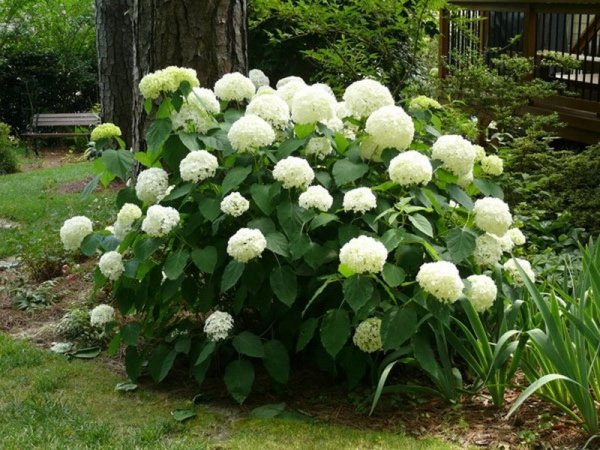
This type of shrub has a great advantage: it can be in the shade for a long time. By mid-summer, huge balls of inflorescences with a diameter of up to 25 centimeters appear.
Gradually, when flowering, the inflorescences acquire a delicate green color, but do not fall off for many more weeks, the bush seems to be dormant, creating a romantic atmosphere.
Hydrangea paniculata
Hydrangea paniculata belongs to the classics of the garden group of hydrangeas.
Flowering begins in the form of pristine white flowers, gradually they are covered with a reddish bloom.
This hydrangea blooms from August to September, its later flowering has its own charm.
Different varieties of hydrangea paniculata differ in size and shape of inflorescences, flowering time and density of large sterile flowers.
Hydrangea “Kyushu” has a very strong aroma.
Mystery blue coloring
The blue color of the flowers depends on the plant variety and the aluminum content in the soil.
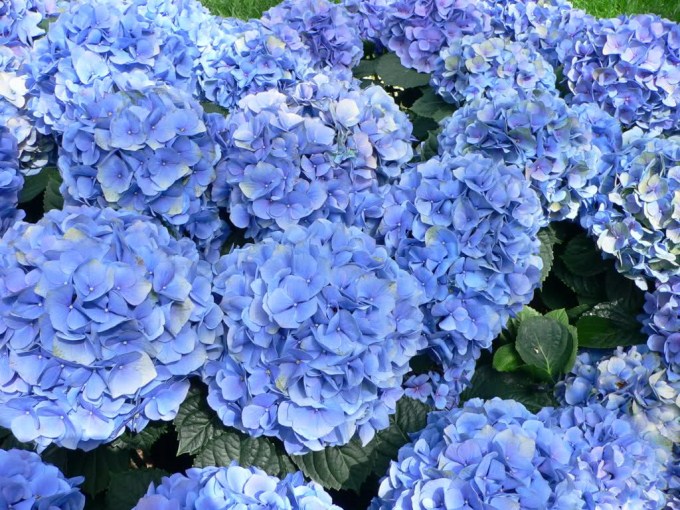
Ie, so that the blue hydrangea retains its unusual color, it is enough to mix the sulphate of aluminum into the water for irrigation once every two weeks.
But hydrangea can consume aluminum only from acidic soil with an acidity index of 4 to 5.
It is best to grow blue hydrangea on garden soil, designed specifically for rhododendrons.
Curly moss hydrangea
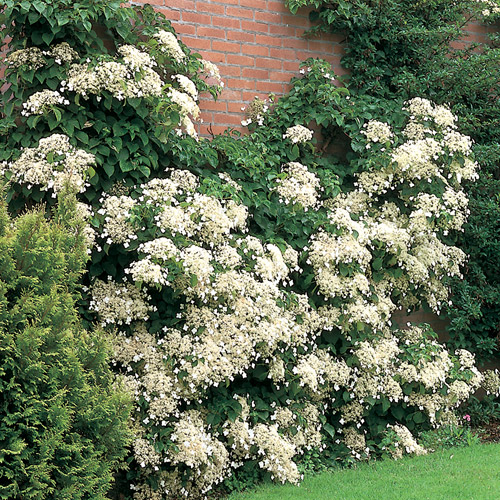
All of the above hydrangeas, are well developed in the vicinity of other plants, but the curly petilated hydrangea is a pronounced individualist, preferring to land at supporting high wall, it clings to the air roots for stone or wooden walls, creating a solid carpet with a huge number of inflorescences.
Hydrangea Treelike Invinsibel Spirit
This variety was obtained in the United States, the inflorescences of the tree hydrangea, which are wonderful for wintering in Russia, were only white, green as they flowering, but each gardener wanted to have a pink variety of hydrangea, but she has a bad winter.
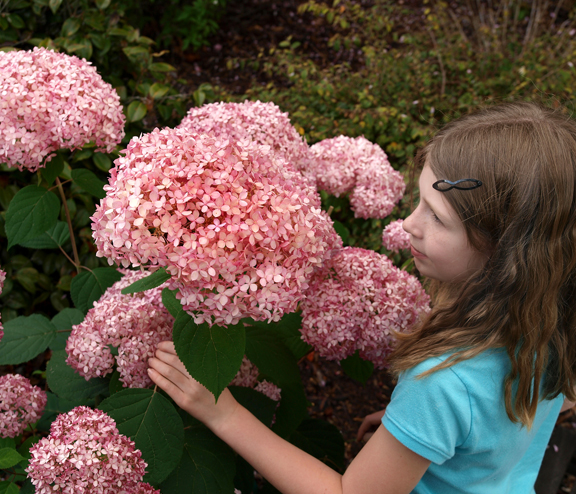
New American variety Invinsibelle Spirit has inflorescences when blooming a dark pink color, then changes color to bright pink.
Like other forms of tree hydrangea, flowering occurs on young shoots - it guarantees flowering even in the coldest winters.
If, after winter, the shoots are preserved, the bush forms many large, with a diameter of 15-20 cm. Inflorescences, and with a strong pruning - large inflorescences with a diameter up to 30 cm, but their number is less.
Breeders promise to re-bloom, it extends the total duration of flowering to 4 months - from June to September.
The bush has a height of 1.2 meters; its diameter is slightly larger.
Agrotechnical cultivation is the same as for hydrangea tree.
Proper pruning hydrangea
Often amateur growers are faced with the problem of rare hydrangea flowering.
In order that hydrangea plentifully blossomed, it is necessary to make correctly shrub pruning.
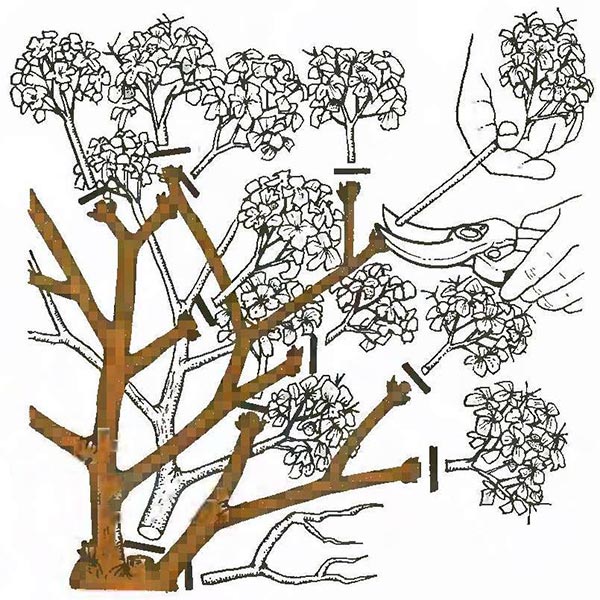
Since the hydrangea is large-leaved, the flower buds are laid on the shoots of the previous year, this means that these shoots need to be preserved in winter, and in spring only the frozen and dry tips of the shoots need to be cut.
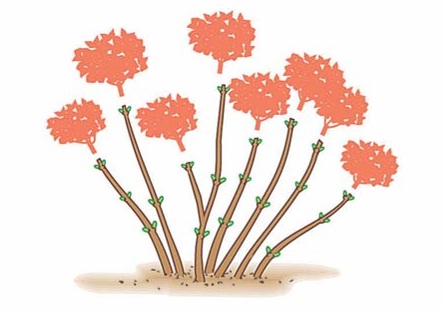
Hydrangea paniculata, on the contrary forms blooming buds on the shoots of the current year, and this means that in spring the branches can be shortened by almost 2/3 and thereby stimulate flowering.
If the bushes do not cut, they quickly grow, flowering deteriorates.
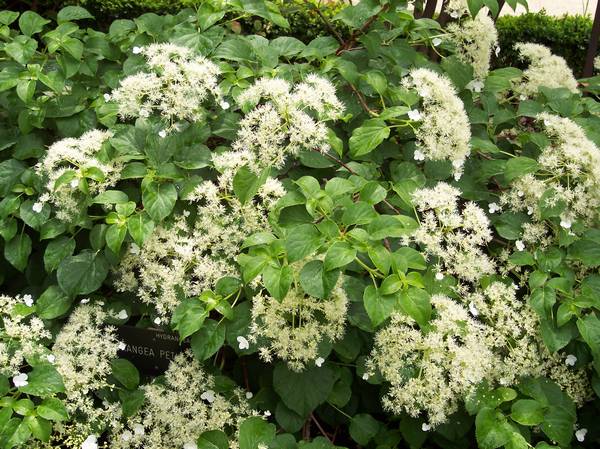
Hydrangea tree blossoms also on young shoots and pruning old branches, almost at the root, stimulates the formation of new shoots and abundant flowering.
Do you want your garden to be fragrant and delight you with a long flowering? Then you need to settle there recognized garden beauty Hortense, called in honor of the princess of the Roman Empire. From July to September, this perennial shrub will delight you with its spherical inflorescences, which have a greenish tint at first, then at the very peak of flowering turning into a bright white color, slightly yellowing towards autumn. And if you plant a large-leaved, or garden, hydrangea, you can achieve pinkish or bluish shades. Let's try to figure out how to change the color of the hydrangea garden.
In nature, there are several dozen varieties of hydrangea. However, only
Garden hydrangea is the only type of hydrangea in which you can change the color of flowers from white to blue or pink
Garden, or large-leaved, hydrangea - the most popular and common plant species, representing ornamental shrub. The scientific name of hydrangea (Hydrangea macrophylla), translated as “water vessel”, is due to the increased water-loving nature of the flower. Hortensia has large, egg-shaped leaves with pointed edges. Shrub blossoms lush spherical volumetric inflorescences. The most common are white or pink color. There are also inflorescences lilac and blue.
Coloring spherical inflorescences depends on the acidity of the soil. The color of the hydrangea can be used to determine the acid-base medium of the soil: pink indicates weakly alkaline or neutral acidity, blue indicates an elevated soil pH.
Therefore, you can change the color of garden hydrangea by increasing / decreasing the acidity of the soil. It is better to take care of this before planting a shrub. To do this, you must pre-determine the place in the garden, prepare the appropriate substrate, plant the plant and monitor the level of soil acidity.
How to test the soil
Any gardener, even an amateur, knows that good harvest depends largely on the knowledge of the chemical composition of the soil of your plot. One of the important indicators is the acidity, or soil pH.
The acidity of the soil is a quantitative measure of the content of acids and salts. The pH value is determined by values from 0 to 14.
In terms of earth mixture, they mean the following
up to 4 - strongly acidic medium;
from 4.5 to 5.5 - acidic soil;
from 5.5 to 6.5 - slightly acidic soil;
from 6, 5 to 7 - neutral ground;
above 7 - alkaline medium.
How to determine the acidity of the soil yourself
The acidity of the soil is extremely accurately determined by a special device, but approximate values can be measured independently.
We offer you some simple and affordable methods for determining soil pH:
- Acetic essence.
It is enough to pour a few drops of vinegar on a handful of earth and watch the reaction. If there is a violent boil, accompanied by the release of carbon dioxide, then you have an alkaline environment. Small bubbles and a weak soil reaction indicate neutral acidity. The absence of any reaction suggests that the soil is acidic.
- Grape juice
In a vessel with grape juice, dip a pinch of soil. The change in color of the drink and the appearance of gas bubbles indicates the normal pH of the soil.
- Currant or cherry leaves.
Fill a few leaves with boiling distilled water. Cool the liquid and throw a handful of earth into it. The change in water color after a while is an indicator of acidity: red water is sour, blue is weakly acidic, green is neutral ground.
- Litmus paper.
Put some soil on a clean piece of fabric. Tie it tightly in a knot and dip it in distilled water. Wait for the water to be well saturated with soil. Lower the litmus paper. The color change will make it possible to draw a conclusion about the state of the soil: from yellow to red - an acidic medium, blue-blue shades - neutral soil. This is one of the most reliable ways. Litmus paper is freely sold in agricultural stores.
The easiest way to determine the level of soil pH is visual. If, upon careful examination of the soil, you see reddish rusty shades, then the soil is strongly acidic. A thin iridescent film on water accumulated after watering or rain is evidence of an acidic soil environment.
Video "How to determine the acidity of the soil and the ways of its deoxidation"
Change the color of the queen's garden
Knowing the acidity of the soil on your own garden plot, you can achieve the desired color of hydrangea. Acidic soil, the pH of which is below 7, will allow you to grow a blue moisture-loving beauty. The alkaline environment (acidity above 7) is good for pink hydrangea. Values of 5, 5 - 6.5 pH will give shades or pink-blue mixture.
However, knowledge of the pH of the soil and the choice of a particular type of shrub is not enough. An important factor is the presence of aluminum in the soil. When the acidity is above 6.5 (neutral and alkaline environment), aluminum is not available to the plant, so the hydrangea will release pink flowers.
Blue hydrangea needs acidic earth to help dissolve aluminum. In this case, the presence of aluminum is more important for the flower than the pH of the soil. In addition, nutrients contained in the soil affect the availability of an element.
In general, the color of the hydrangea is influenced by the variety of the shrub, the acidity level of the soil, aluminum and the fertilizers used.
After planting, hydrangea, adapting in a new environment, can change color independently. A year later, the queen of the garden can please you at once in several shades on one bush.
To control the color of the shrub it is necessary to adjust the pH of the soil. This begs the question of what to water to change the color of the queen of the garden.
There are special agrotechnical techniques that help achieve a change in the shades of the inflorescences, which are best used at the early stage of shrub growth. Consider them in more detail.
Pink hydrangea
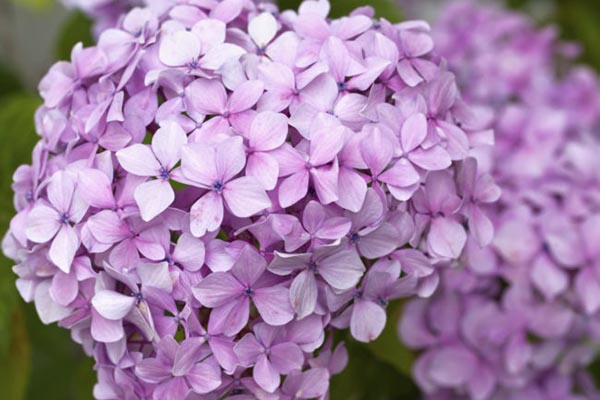
Change the color of the hydrangea garden from white to pink
To change the color of hydrangea from white to pink, you need to maintain a pH higher than 6.5. If the acidity of the soil of your site is as follows, hydrangea will throw out pink inflorescences. At the same time there is no need to take additional measures.
Sour soil several times a year should be fertilized with chalk, limestone or dolomite flour. But do not overdo it: it is enough to achieve indicators of acidity at the level of 6-6,2. At values exceeding these indicators, the formation of soil chlorosis or iron deficiency is possible.
To saturate the soil with essential nutrients, feed the soil with fertilizers with a high concentration of nitrogen and phosphorus, but a low concentration of potassium. Aluminum in combination with phosphorus form insoluble compounds, which will not allow the appearance of blue inflorescences. Choose N: P: K fertilizer in proportion close to 25:10:10. Ammonium monophosphate is excellent.
If your site is too acidic, then professional gardeners recommend planting hydrangea in large pots, using peat substrate with a small amount of aluminum salts as the soil. The best in this case is recognized as a universal substrate, sold in special stores. This will greatly simplify the cultivation and care of the pink leaf garden queen.
Blue moisture-loving beauty
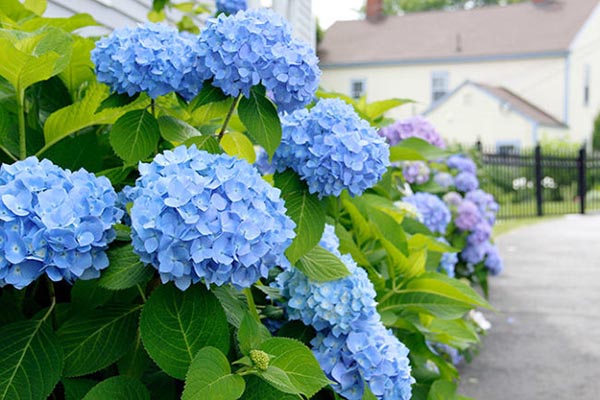
Change the color of hydrangea to blue
To change the shade of inflorescences to blue, it is necessary to maintain an acidic environment (below 5, 5 pH) with the content of soluble aluminum available for hydrangea.
If in your garden acid earth prevails with a sufficient concentration of aluminum, then the hydrangea will independently fulfill your desire by firing blue caps.
To increase the acidity of the soil, you can specially acidifying the root zone. To do this, it is enough to add high-moor peat or sulfur used in agriculture to the landing hole. Then, water regularly with aluminum sulfate in the proportion of 15 g per liter. Make sure that the soil is moistened with a special solution before watering.
To change the color of a previously planted hydrangea, pour high-moor peat or conifer bark into the ground near a bush.
Changes in shade can be affected by feeding with complex fertilizers containing potassium (high concentration), phosphorus (low percentage), nitrogen (average value). The ideal ratio would be N: P: K, close to 10: 5: 20. Do not use bone meal or superphosphate.
Growing allowed blue hydrangeas in huge vessels using ready-made substrates. Professionals advise to stop the choice on the acidic substrate for conifers.
Video "How to change the color of hydrangea to blue"
Adhering to the above recommendations, you will definitely get the desired result. However, do not count on an instant change in the color of the hydrangea. This period can take from several months to a year depending on weather conditions, the quality of fertilizers and other factors.
Beautiful hydrangea pink with proper care can be an ornament to the richest flower garden. The tree bush during flowering period is covered with large caps of pink inflorescences, and if desired, they can contribute to the acquisition of a blue color. To acquire such a decoration, you need to know everything about the care, watering, planting and reproduction of this plant.
Planting and care for a young bush
Having decided to start a hydrangea, a gardener must understand that he is getting on a rather long and difficult path. Although this flower is not considered to be very capricious, the planting and the ability to take root in a new place completely fall on the shoulders of a person. But first things first.
First you need to buy a healthy and promising seedling. Young hydrangeas best survive if they are transplanted along with a clod of earth on the roots, but a bare rhizome can quickly and easily take root. The acquired shrub should be carefully examined, future shoots should be visible on it, the branches should not be black and dry in appearance. The root is soft and malleable - this is the guarantee of a healthy bush.
Soil is very important for future growth and flowering, and since the hydrangea after planting has been growing in one place for years, it is necessary to thoroughly prepare for planting.
First, they determine the planting site: it should be an illuminated part of the garden, without drafts, it is desirable that the natural moisture of the soil is present, this will simplify the need for watering.
Under the ground they dig a hole, which should be 2 times larger than root system planting material. The bottom of the pit is filled with humus and peat, even if the soil is considered fertile. Then they pour a small mound of a mixture of soil and sand, a shrub is placed on this hill, and the root is gently spread in different directions. And only after that the pit is filled up, trying to deepen the base 2-3 cm deep.
Landing is best done in the spring, autumn planting may not give positive results. Very important mulch land. It is made from freshly cut grass, coniferous material, half-rotten leaves. This will not allow the roots to dry out, prevent the growth of weeds.
It is very important in the first year of life to fertilize hydrangea. To do this, use any mineral fertilizers, solutions of mullein or complex compositions for hydrangeas. It is important not to forget about watering the plant, as hydrangea loves moisture.
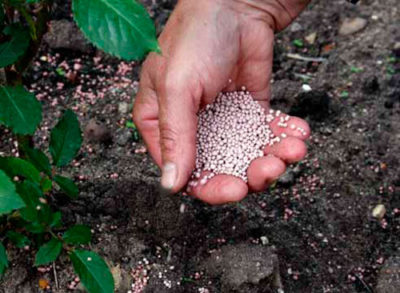
A very important point is the loosening of the soil, after the seedling is actively set in growth, as its root system loves lightness and air. This should be done very carefully, since the roots are practically on the very surface of the earth.
Hortensia attracts many gardeners, both experienced and beginners. The plant is valued for its decorative appearance, unusual leaf shape and lush bloom. It owes its name to the French princess Hortensia. Later scientists called it hydrangea, which translates as "a vessel with water." This emphasizes the fact that the plant needs a lot of moisture. However, the scientific name did not stick with the florist. Until now, preference is given to the original version.
Varieties
Hydrangea is most often grown in gardens, but it is possible to maintain a flower at home. There are about 80 varieties of this plant. There is also a division by type:
- paniculata;
- anabel;
- large-leaved;
- petiolate;
- tree;
- pink
AT room conditions It is recommended to contain large-leaved hydrangea. This is due to the fact that it is less resistant to frost and does not tolerate temperature drops. Various types of flower are common in the territories of East Asia, South and North America, Sakhalin, the Kuril Islands, and Japan. China is considered the birthplace of large-leaved hydrangea. In a warm subtropical climate, the plant can reach 4 meters in height. In colder climates, it can only grow to a meter. In nature, painted today. Breeders have bred new varieties with white inflorescences. But the most unusual is blue.
Temperature and location
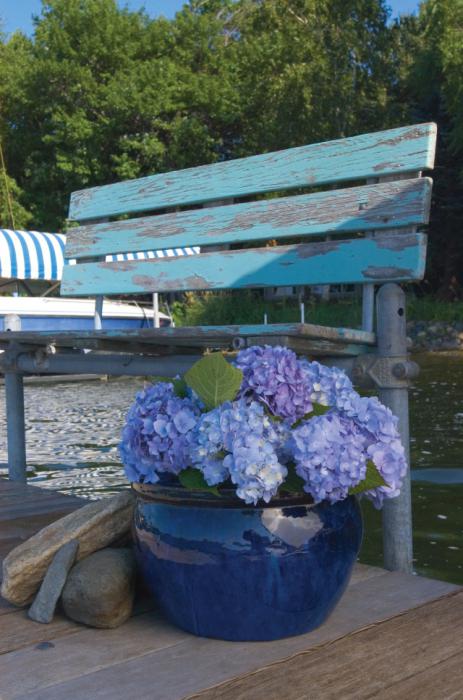
Often, novice gardeners can hear that the plant is difficult to maintain. This opinion arises from those people who do not know how to care for blue hydrangea. You should always remember that the flower belongs to the heat-loving. In the summer he needs a temperature of 18-20 degrees. If the room is warmer, the plant will start dropping leaves. The flower loves fresh air, so in the summer it is advisable to bring it to the balcony. However, you must avoid drafts and cold air flows. In winter, the optimum temperature is 4-8 degrees.
Lighting
In the summer, in the period of flowering and active growth, the hydrangea should be located in the penumbra or in the place where the light is diffused. It is best for the flower when the top is lit, and the stem and leaves are in faint shade. Hortensia blue does not tolerate the direction of the sun's rays, however, very dark places also do not suit it. The flowering period begins later, and little plants appear on the plant. In addition, the lack of lighting leads to the fact that the blue hydrangea becomes weak. Do not allow contact of the flower with the glass. This will cause burns on the leaves.
Humidity. Watering
In the period from spring to late autumn, blue hydrangea requires abundant watering. However, it is important not to overdo it. Watering is done as the topsoil dries. Water should be soft. Periodically, the plant must be sprayed. In winter, the frequency of watering is reduced to 1 time in 1.5 months. Hydrangea blue is able to endure a little dryness, but one should not allow complete drying of the earthy coma.
The soil
For planting plants, you can take the finished substrate. If the necessary soil in the store was not found, then you can prepare it yourself. To do this, take 3 parts of sod, 3 parts of leafy ground and 1 part of sand. Hortensia loves acidic soil. The pH should be 4-5.5. The more acidic the soil becomes, the darker the flower becomes.
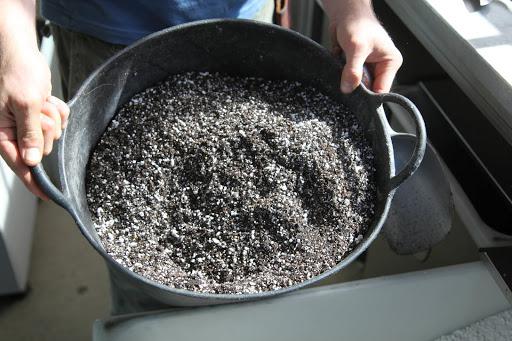
Top dressing
During flowering and active growth room hydrangea Blue requires additional power. For this purpose, a complex mineral fertilizer is used for plants that prefer acidic soils. Feed once a week. Per liter of water is enough 2 g of fertilizer. It is worth noting that a large amount of it badly tolerates any plant, including blue hydrangea.
Planting and care. Reproduction. Transfer
There are several types of the most simple and effective for indoor flower is grafting. To do this, take the lower young shoots with a length of 7-8 cm. They should be 3-4 pairs of leaves. Cuttings need to be straight, not at an angle, at a distance of 3-4 cm from the first node. Lower leaves are removed. Planting is done in deep containers filled with a mixture of peat and sand to a depth of 1.5-2 cm. You can cover the cuttings with a glass bell, but it is better not to do this, as they can rot.
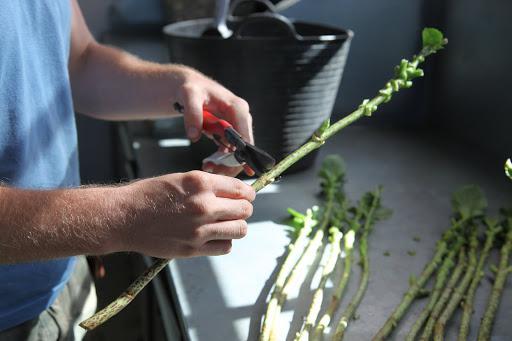
3-6 weeks is enough to make the blue hydrangea take root. Care for a young plant needs careful. In the first seven days it is sprayed up to 4 times a day, then reduced to 1-2 times. After rooting, the plants are transplanted into pots with prepared soil. To bush was more magnificent, it should be pinched in May. The hydrangea will bloom next year. 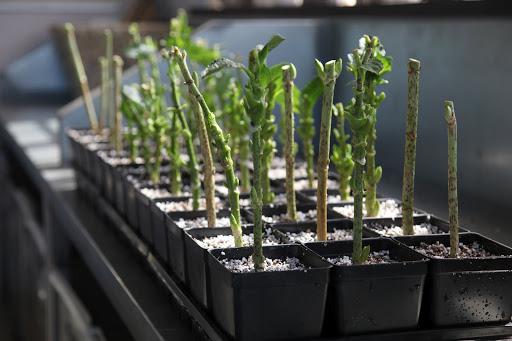
If the hydrangea bush has grown big, then it is better to plant it. For this, the plant is divided in half so that both top and root are on both parts. Hydrangea bushes are planted in a flower pot and fed with fertilizers. Additionally, the root slice is treated with phytohormones.
Pruning
It is carried out in the spring before the beginning of the vegetative period. The essence of the procedure is to remove weak and strongly stretched shoots and old inflorescences. As a result, the plant will bloom better. In addition, there will be new strong shoots. But do not be zealous. Heavily cut hydrangea blooms badly. On the shoots need to leave from 2 to 6 pairs of healthy buds. After pruning, hydrangea does not need to be fed. If the hydrangea grows too thick, then part of the shoots can be removed by cutting at the root.
Rest period
Novice growers may be concerned, noticing that the hydrangea leaves fall. If this happened in winter, there is no reason for excitement. The flower began a period of rest, which lasts about 3 months. Of course, it is difficult to recognize a blooming beauty in bare branches, but if you wait for the summer, you can be sure that this is the same beautiful blue hydrangea. How to care for the wintering flower? This process is very simple. Watering is significantly reduced, but the earthen clod cannot be allowed to dry. Fertilizing is not needed. Until March, hydrangea is cleaned in a cool dark place. Young plants, whose shoots are not woody, do not shed their leaves and hibernate without entering a state of rest. 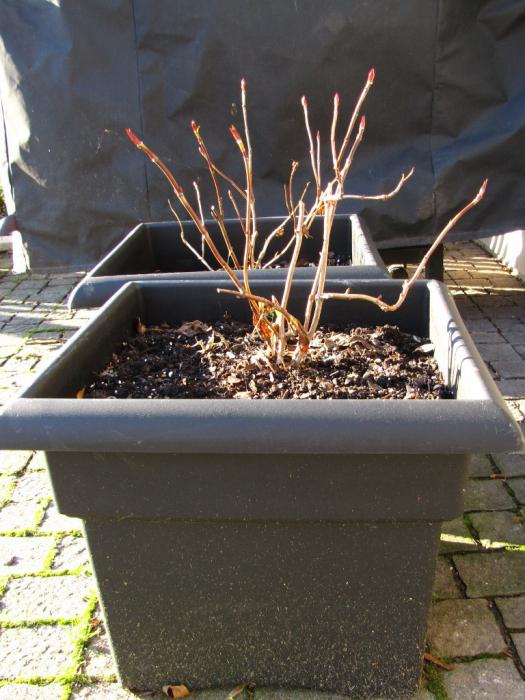
Diseases and pests. Ways to fight
Among the pests stand out:
- Aphid. To get rid of the pest, you need to treat the plant with soapy water. In the case of severe damage, you will have to use phosphoorganic insecticidal and acaricidal preparations of a broad spectrum of action.
- Spider mite Spraying will help in the fight against it. Water should be used warm. If you can not achieve a positive effect, you can use the drugs used to eliminate aphids.
Hydrangea is subject to the following diseases:
- Stem nematode. Leaves, stem and inflorescences are subject to the disease, as a result of which the plant loses its attractiveness. To save the affected flower is impossible. It will have to be destroyed to avoid spreading the disease to other plants.
- Downy mildew. Manifested in the leaves and stems in the form of oily spots. Over time, they turn yellow and increase. On the back of the affected leaf, a yellowish patina occurs. Due to the high humidity and temperature of 18–20 degrees, blue hydrangea is affected by powdery mildew. Care and treatment of plants consist in the treatment of affected areas of the plant with copper-soapy water. In 10 liters of water must be diluted (15 g) and (150 g).
- Chlorosis. Hortensia, affected by this disease, has light leaves with dark veins. Chlorosis causes a large amount of lime or humus in the soil. To return the plant to its former appearance, it is necessary to dilute potassium nitrate (40 g) in 10 liters of water and water the flower 2-3 times. After 3 days, use the solution in the same proportions.
- Hortensia is very sensitive to light and watering. If the flower lacks moisture, its leaves will begin to turn yellow and curl. Excessive watering leads to decay of the roots. Most often this happens during a period of rest when the temperature is significantly reduced. Excessive refreshment leads to the formation of light spots on the leaves. With a lack of plant grows slowly and does not bloom.
- Quite often novice growers are faced with the fact that the hydrangea leaves wither. The causes of this problem are several. First you need to find out if the flower gets enough moisture. Perhaps the plant is in direct sunlight. Leaves can wither from a lack of nutrition, namely from a lack of nitrogen fertilizers. If the location is chosen correctly, watering is sufficient and regular feeding is present, then hydrangea is sick with chlorosis.
The flower can be grown not only on the windowsill, but also on the street, of course, if the climate allows. Hydrangea will not leave anyone indifferent, thanks to its unusual appearance. She is not the most complex plant in the care. If you wish, even a novice will cope with it, and beautiful flowers will be a reward for your care.
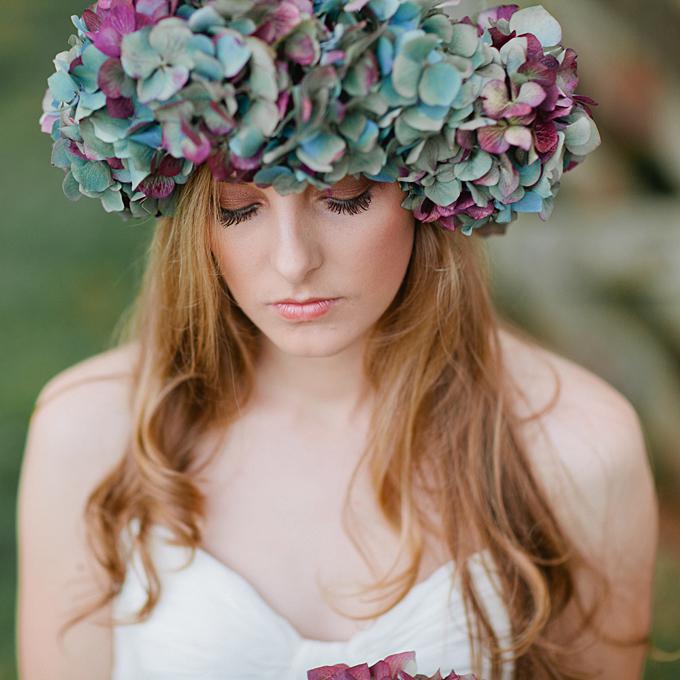
Blue hydrangea can also be used in design. Her decorative look with ease decorate any room. The flower is perfect for decoration of a theme party or wedding. If you need to create an atmosphere of tenderness and romance, hydrangea perfectly cope with this task.

